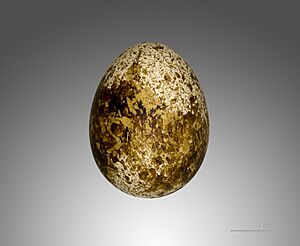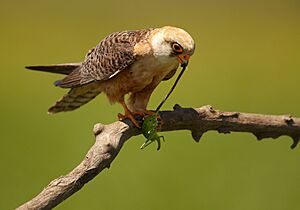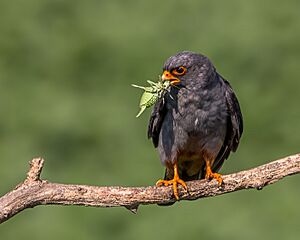Red-footed falcon facts for kids
Quick facts for kids Red-footed falcon |
|
|---|---|
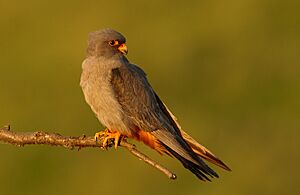 |
|
| Male | |
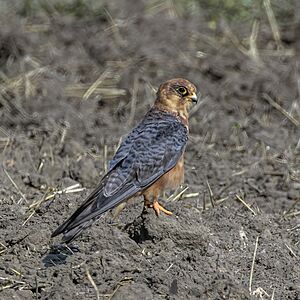 |
|
| Female both near Kecskemét, Hungary |
|
| Conservation status | |
| Scientific classification | |
| Genus: |
Falco
|
| Species: |
vespertinus
|
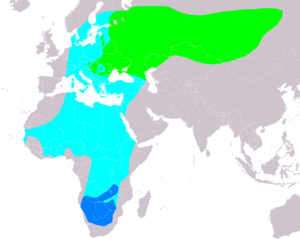 |
|
| Range of F. vespertinus Breeding Passage Non-breeding | |
| Synonyms | |
|
Falco vespertinus vespertinus Linnaeus, 1766 |
|
The red-footed falcon (Falco vespertinus) is a cool bird of prey. It belongs to the Falconidae family, which includes all falcons. You can find this bird in eastern Europe and Asia. Sadly, its numbers are dropping fast because of habitat loss and hunting. These falcons are migratory, meaning they fly south for the winter. They spend their winters in Africa. Sometimes, they wander to western Europe. In 2004, one was even seen in North America for the first time! It was found on Martha's Vineyard in Massachusetts.
Contents
About the Red-Footed Falcon
What's in a Name?
The name Falco comes from a Latin word meaning "sickle." This is because of the bird's curved claws. The species name vespertinus is Latin for "of evening." This might be because they are often seen hunting in the evening.
The Amur falcon is a very close relative of the red-footed falcon. They used to be considered the same species. Now, scientists know they are different but still very similar.
How to Spot Them
Red-footed falcons are medium-sized birds with long wings. They are about 28 to 34 centimeters (11-13 inches) long. Their wingspan is about 65 to 75 centimeters (25-30 inches). An average falcon weighs about 155 grams (5.5 ounces).
- Males: Adult males are mostly blue-grey. They have bright red feathers under their tail and red legs. Their underwings are a solid grey color.
- Females: Females have grey backs and wings. Their heads and bellies are orange. They have a white face with a black stripe near their eyes and "mustaches."
- Young Birds: Young falcons are brown on top and light brown underneath. They have dark streaks on their bodies. Their face looks similar to the female's.
Where They Live
The main places where red-footed falcons live in Europe are southern Russia and Ukraine. Many also live in Hungary, Romania, and Serbia. Smaller groups are found in Italy, Bulgaria, Moldova, Austria, Slovakia, and Belarus. They sometimes breed in the Czech Republic and Baltic States, and even Germany.
In Asia, they live in a narrow strip of land. This area stretches east to the upper Lena River. They live in open areas with some trees, often near water. They prefer steppe habitats, which are like large grasslands.
For winter, these falcons fly far south to southern and eastern Africa.
Life Cycle and Behavior
Red-footed falcons like to live in groups, especially when they are raising their young. They don't build their own nests. Instead, they reuse old nests made by other birds like rooks. They usually lay two to four eggs.
These birds can live for about 13 years in the wild. In zoos or special care, they can live up to 18 years.
Nesting Habits
Red-footed falcons often nest in colonies, which are large groups. They usually choose nests that are higher up than others. These nests are often 13 to 20 meters (42-65 feet) above the ground. They are also usually close to the top of the tree, about 3 to 4 meters (10-13 feet) from the very top. They like to nest near the edge of woods, not on single trees in the middle of nowhere.
Nesting in groups helps them raise more young successfully. If they nest alone, fewer young birds survive.
Challenges in Hungary
In Hungary, scientists have studied red-footed falcons. They found that the number of places where rooks build nests (called rookeries) has gone down. Rooks are important because falcons use their old nests. In the 1980s, many rooks were killed, which caused their population to crash. This meant fewer nests for the falcons.
To help, people have set up artificial nest boxes for the falcons. This helps create more places for them to breed. Researchers also found that more natural grasslands help falcons find good nesting spots. But more broad-leaved forests can make it harder for them.
Family Life in Serbia
Near a village in northern Serbia, researchers watched red-footed falcon nests. They found that both parents take care of the eggs and chicks. However, the female falcon spends more time sitting on the eggs and with the very young chicks. When the chicks get older, both parents are involved.
When there's a disturbance, females often defend the nest more than males. As the chicks grow, the parents become more protective. They will try harder to scare away anything that might harm their nest.
Surveys in Serbia showed that the number of red-footed falcons has been decreasing. In 1990-1991, there were hundreds of pairs, but ten years later, the numbers were much lower. Most of the falcons still nest in rook colonies.
What They Eat
The red-footed falcon is a bird of prey, so it hunts for its food. Its diet includes many different things:
- Insects: Like large green bush-crickets and beetles.
- Amphibians: Such as spadefoot toads.
- Reptiles: Like sand lizards.
- Mammals: Such as common voles.
- Birds: They sometimes eat bird nestlings.
These falcons hunt in a special way, similar to the common kestrel. They often hover in the air, looking down at the ground. Once they spot something, they dive quickly to catch it.
When feeding their young, the youngest chicks get the most food. They also get bigger prey like toads and lizards. Older chicks get fed less often and with less variety. Young chicks mostly eat insects, while older ones eat mostly Orthoptera (like grasshoppers).
Dangers They Face
One big problem for red-footed falcons is losing their natural nesting spots. People sometimes shoot into rook nests, kill the birds, or cut down trees where they live. This destroys the homes falcons rely on.
Pesticides are also a threat. They reduce the number of insects, which is a main food source for the falcons. This makes it harder for them to find enough food.
Another danger is electrocution. Falcons sometimes perch on power lines, and they can get hurt or killed by the electricity. In Hungary, many rooks were poisoned in the past. This made falcons change their nesting habits, and large colonies almost disappeared. This is bad because falcons are more successful when they nest in bigger groups.
Helping Red-Footed Falcons
There are about 300,000 to 800,000 red-footed falcons in the world. About 26,000 to 39,000 pairs live in Europe. Most of them breed in the grasslands of Russia and Central Asia. Many also live in Ukraine, Romania, and Hungary.
Red-footed falcons are considered an "umbrella species." This means that if we protect them, we also help protect many other species that live in the same areas.
Conservation Efforts
A special program, funded by the EU, started in 2006 to help these falcons in Hungary and western Romania. The goal is to increase their numbers.
- Artificial Nests: The program creates artificial nest box colonies. This gives the falcons more safe places to nest.
- Protecting Nests: Sometimes, predators like martens attack nests. The program uses methods to keep these predators away.
- Power Line Safety: Electric pylons can be dangerous. The program finds and insulates exposed cables to prevent electrocution.
- Rook Management: Since falcons rely on rook nests, the program is working on a plan to manage rooks. This helps prevent conflicts and ensures there are enough nests for falcons.
Scientists continue to study the falcons to find new ways to help them. Artificial colonies are a good way to help them in the short term. Also, changing farming and land-use practices in Central Europe could help the species. In Bulgaria, there are fewer breeding sites available for the birds, so finding more is important.
Images for kids
-
A colony of red-footed falcons





